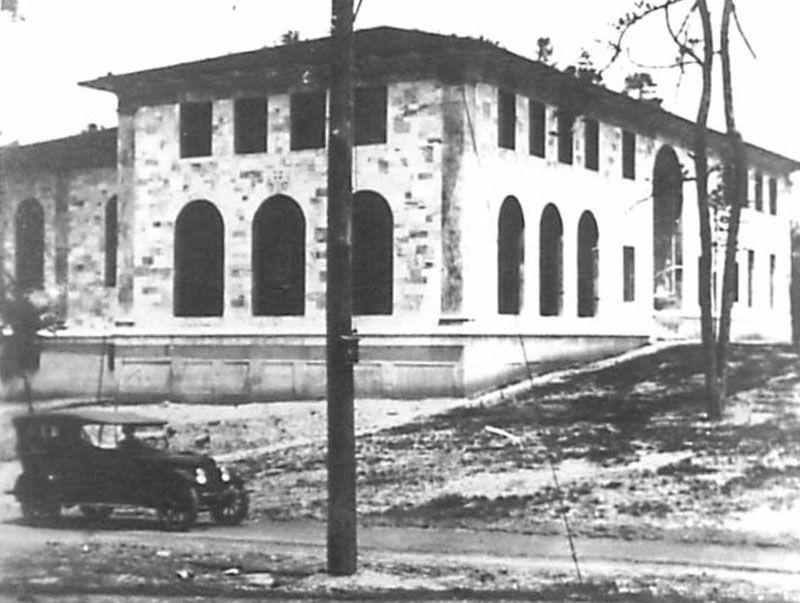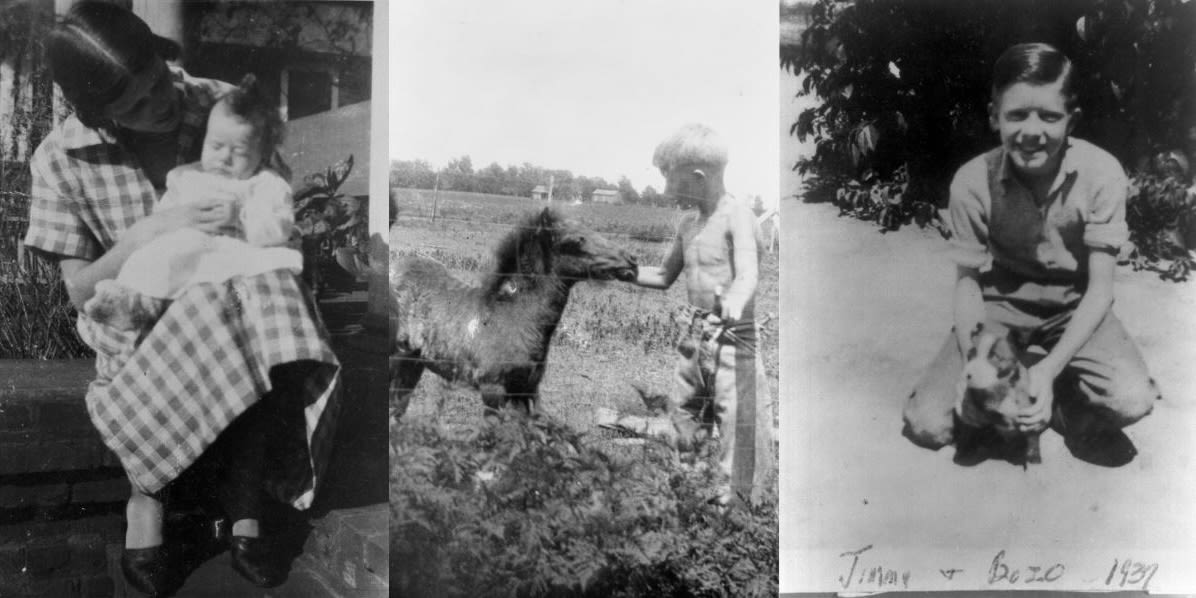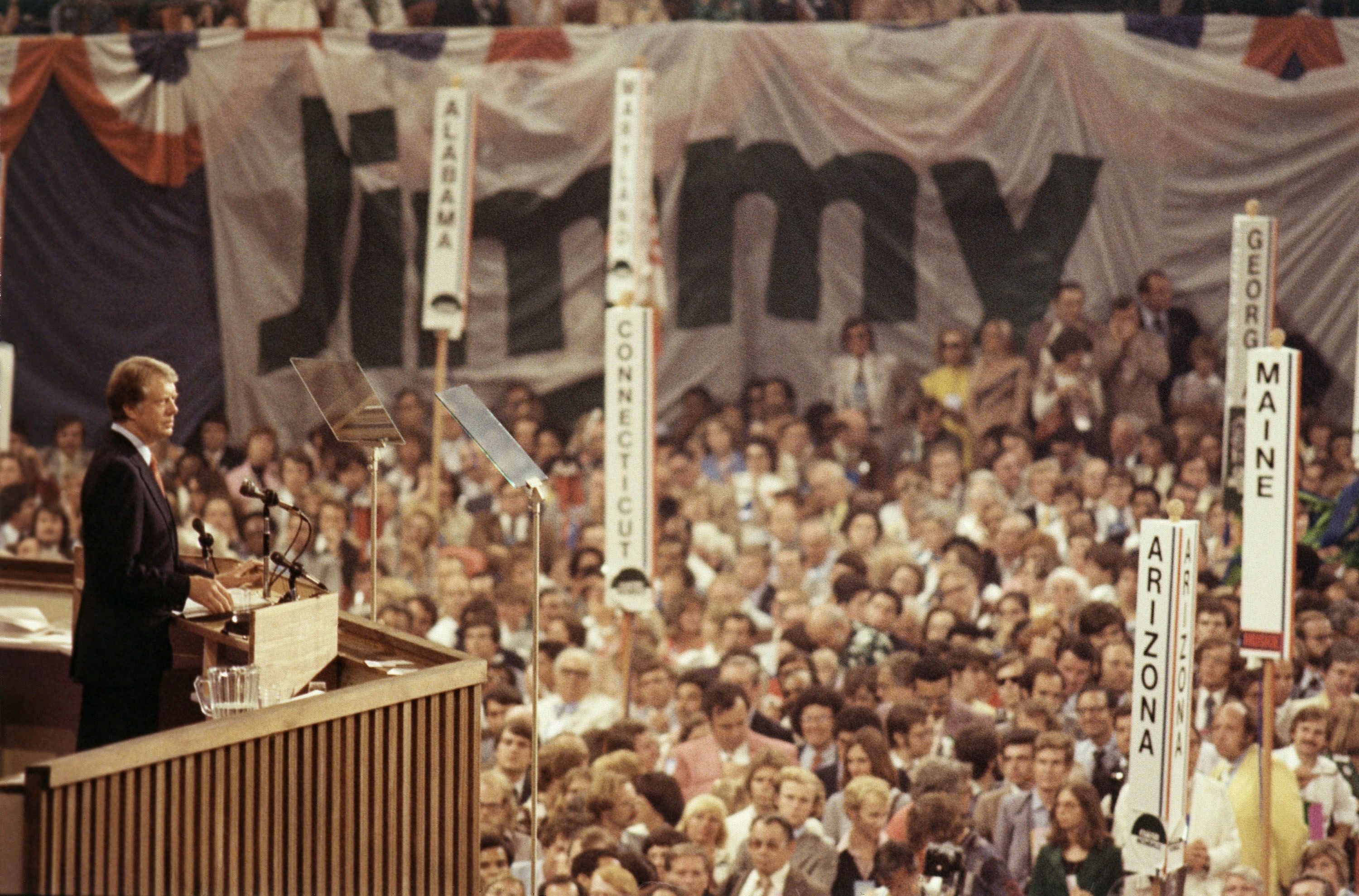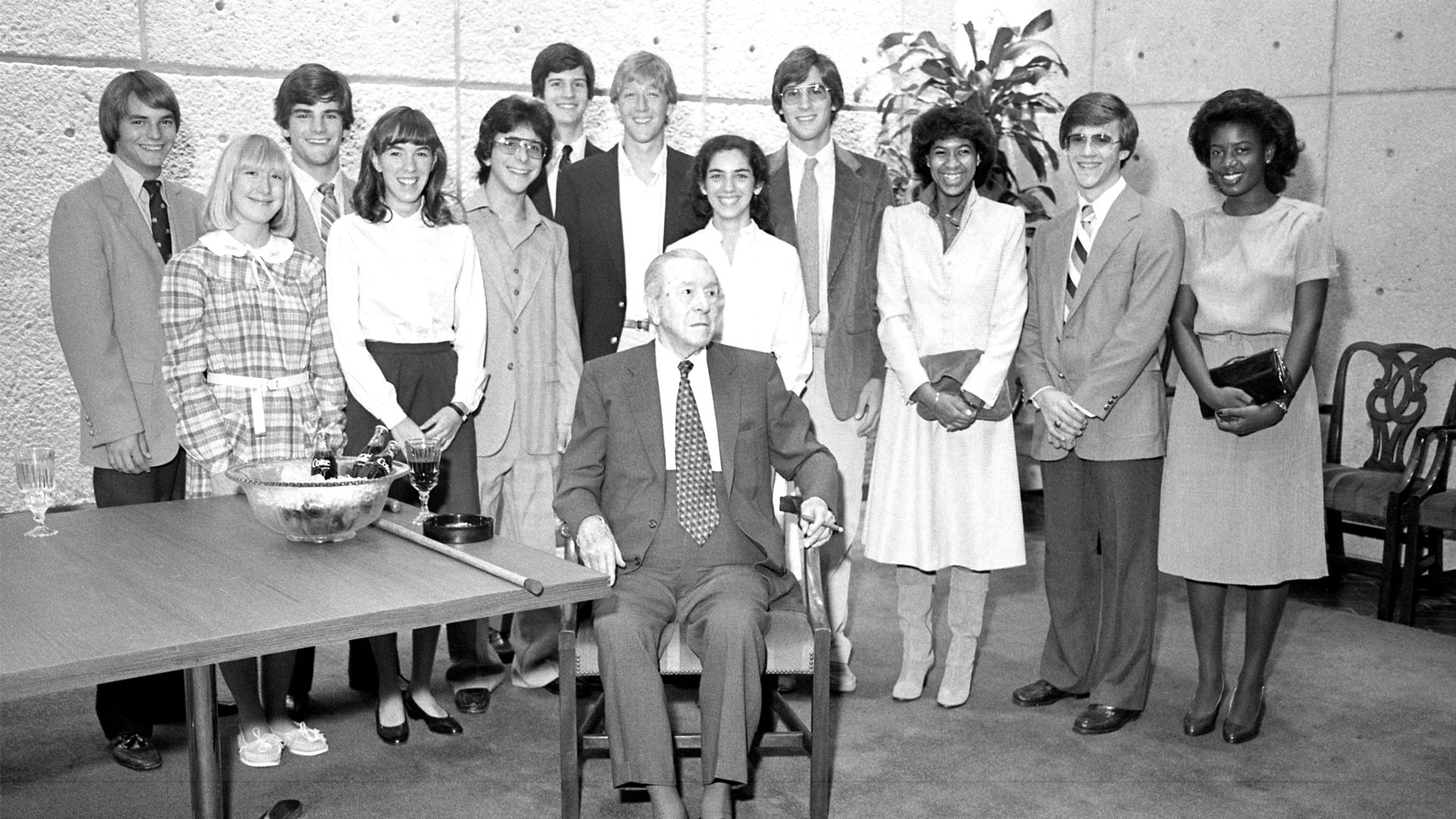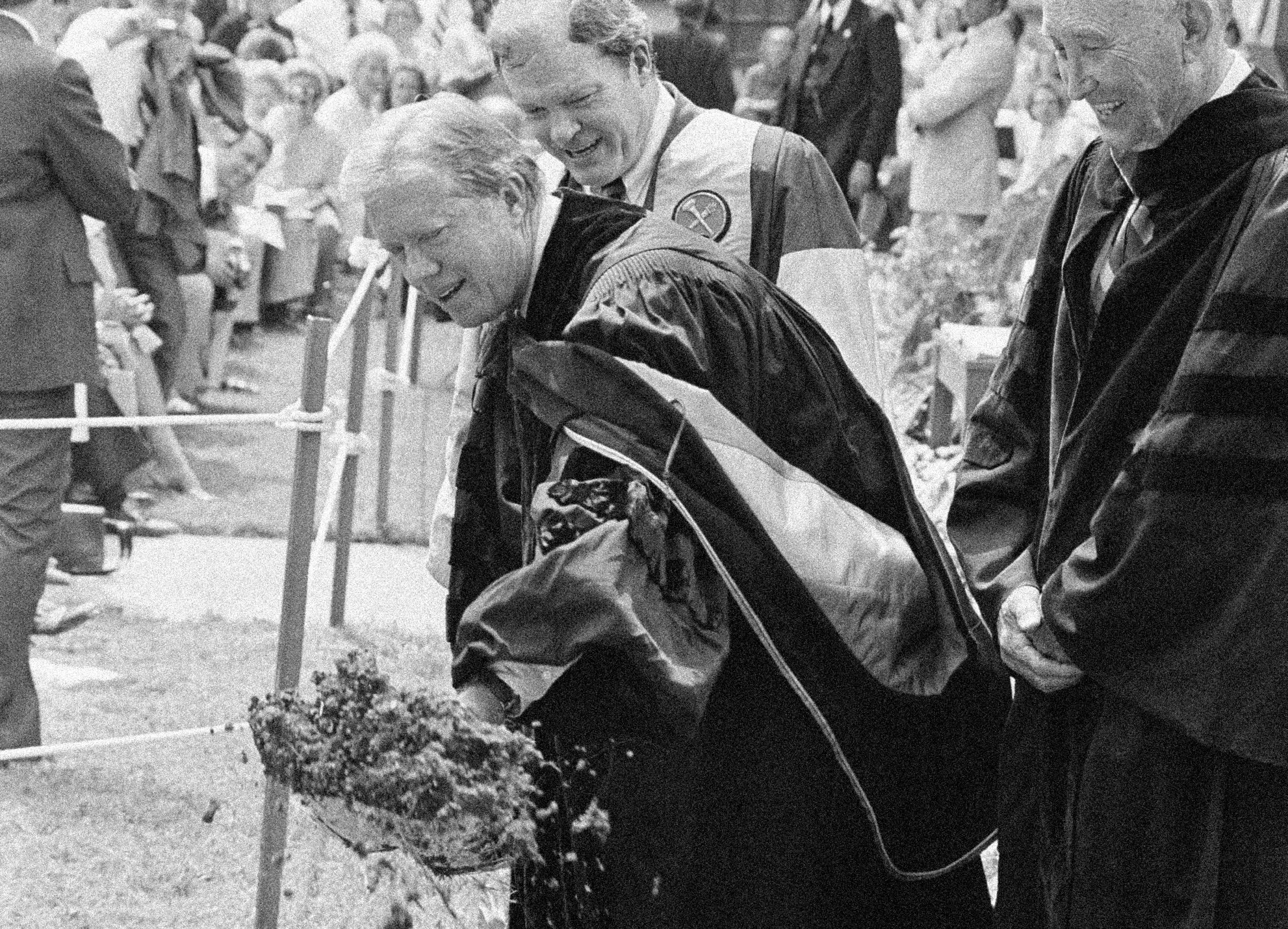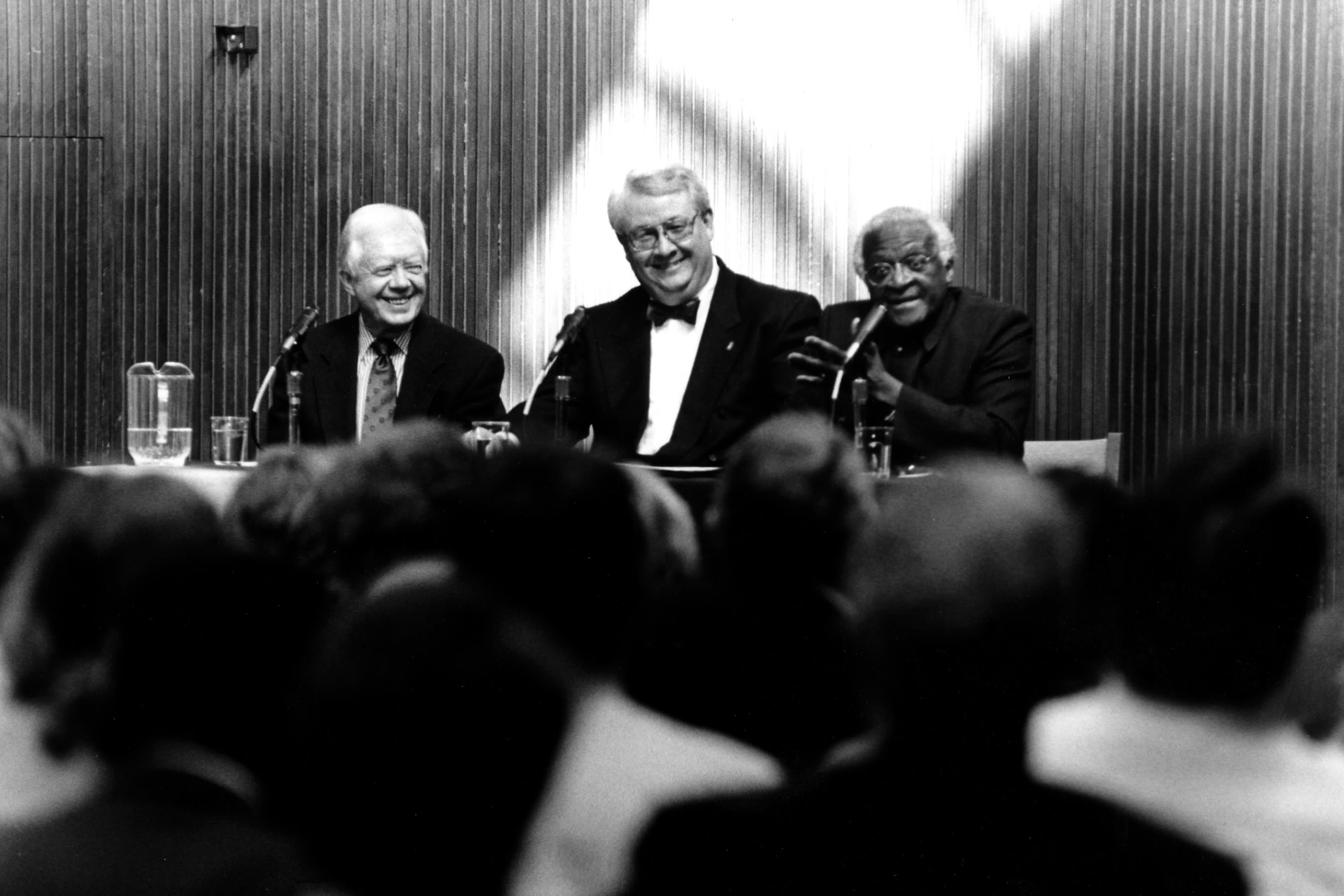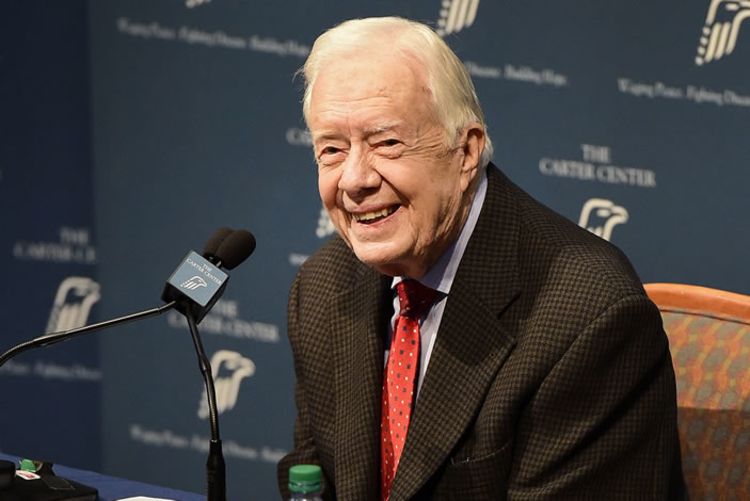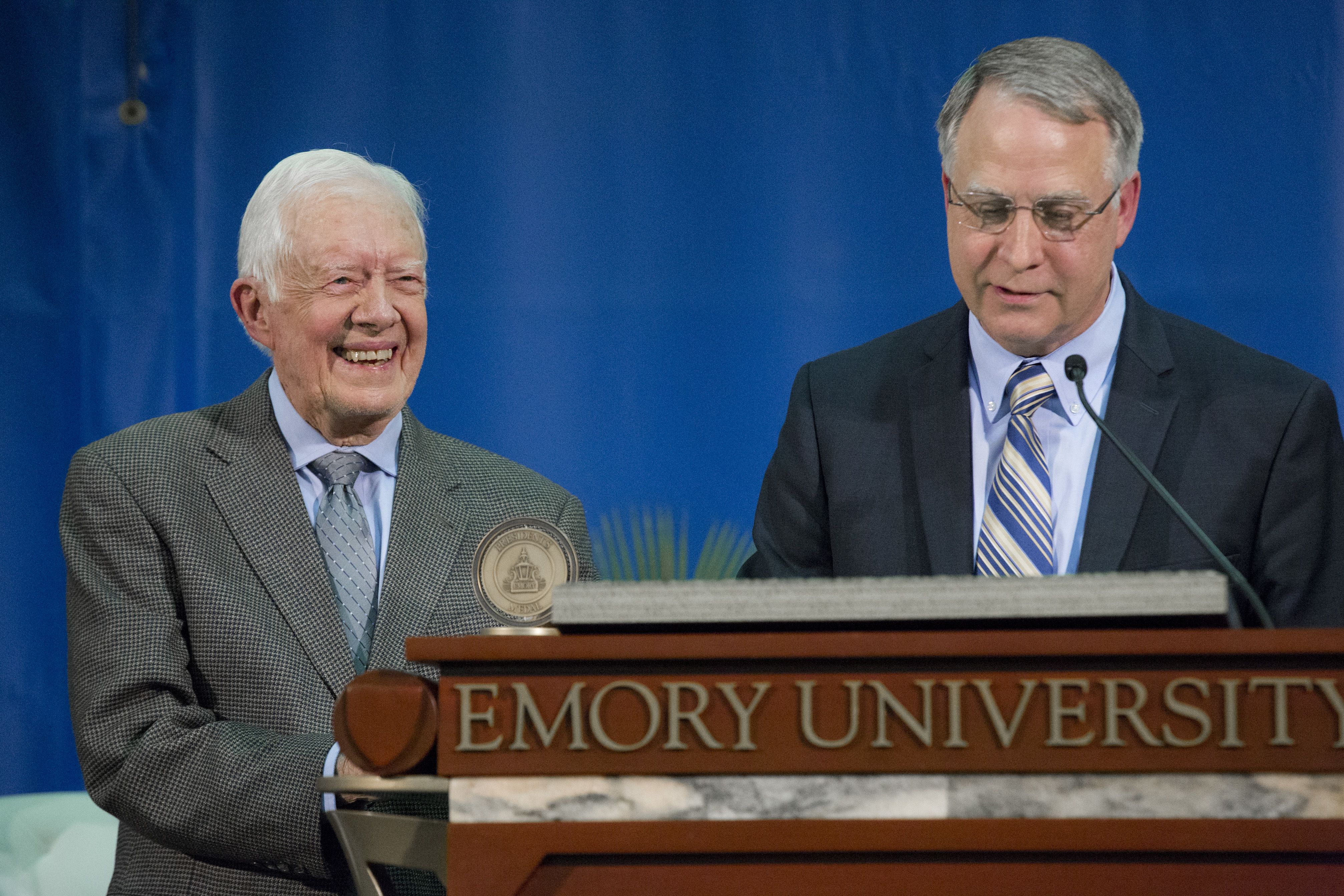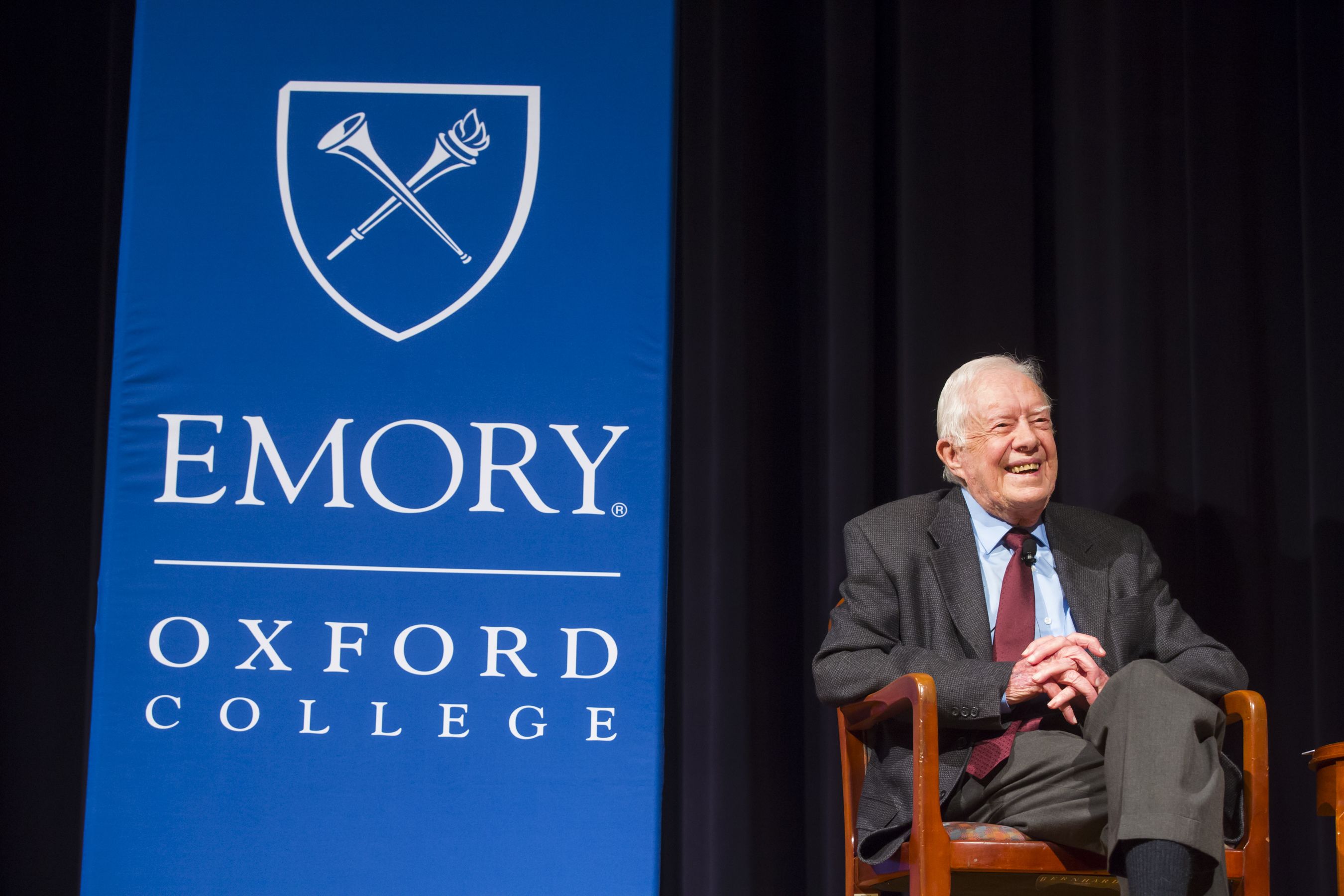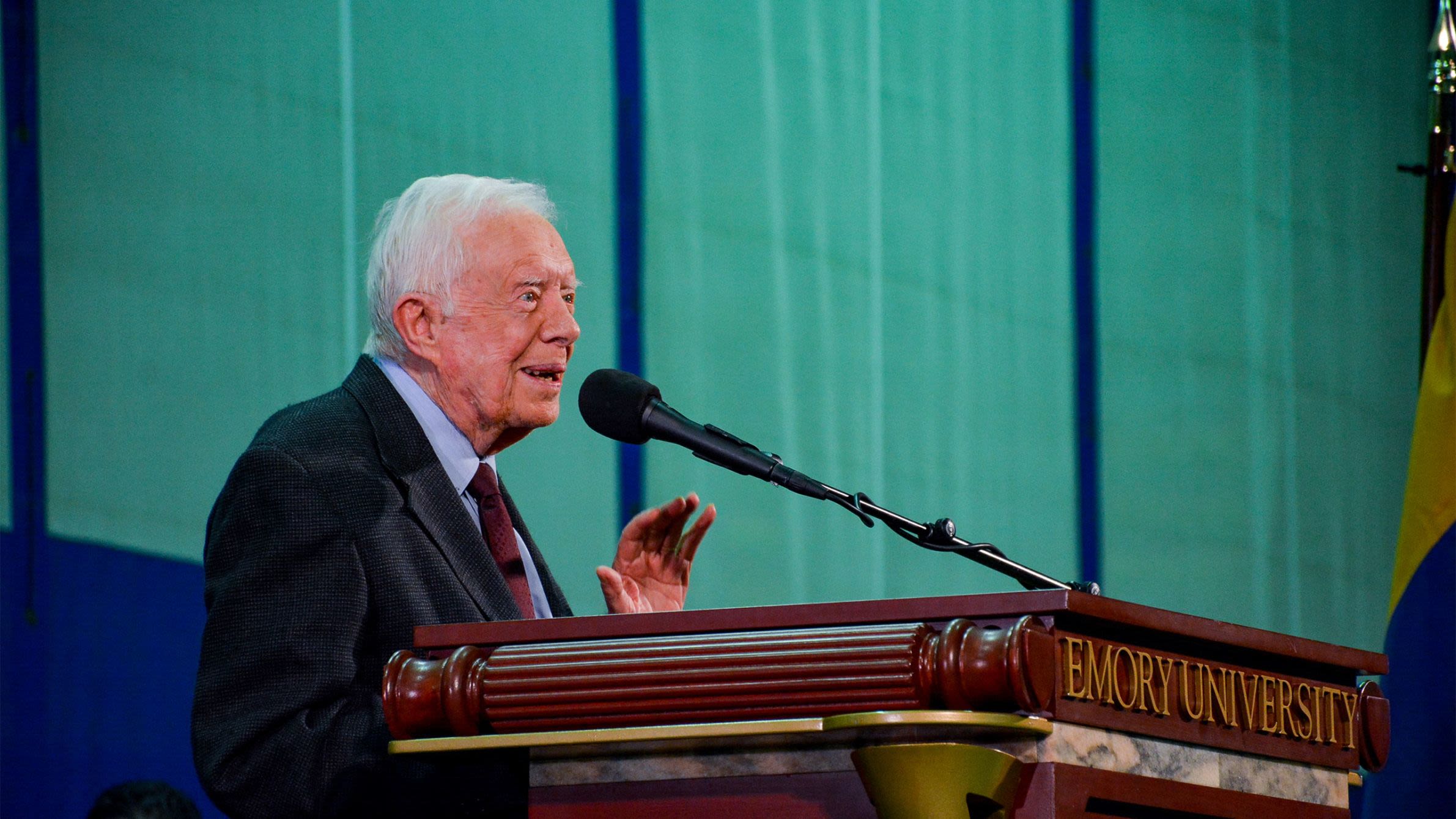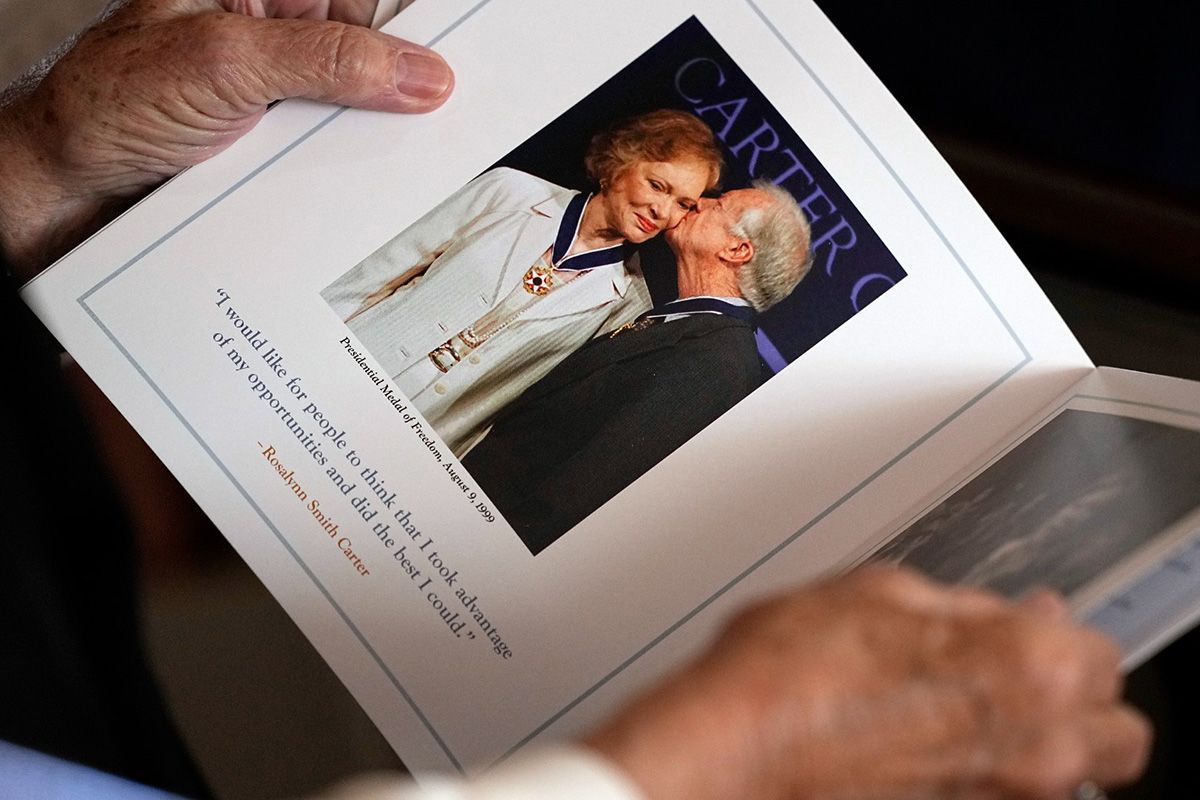Emory celebrates President Jimmy Carter at 100
Scroll through the decades to see milestones in President Carter’s life and collaboration with Emory University
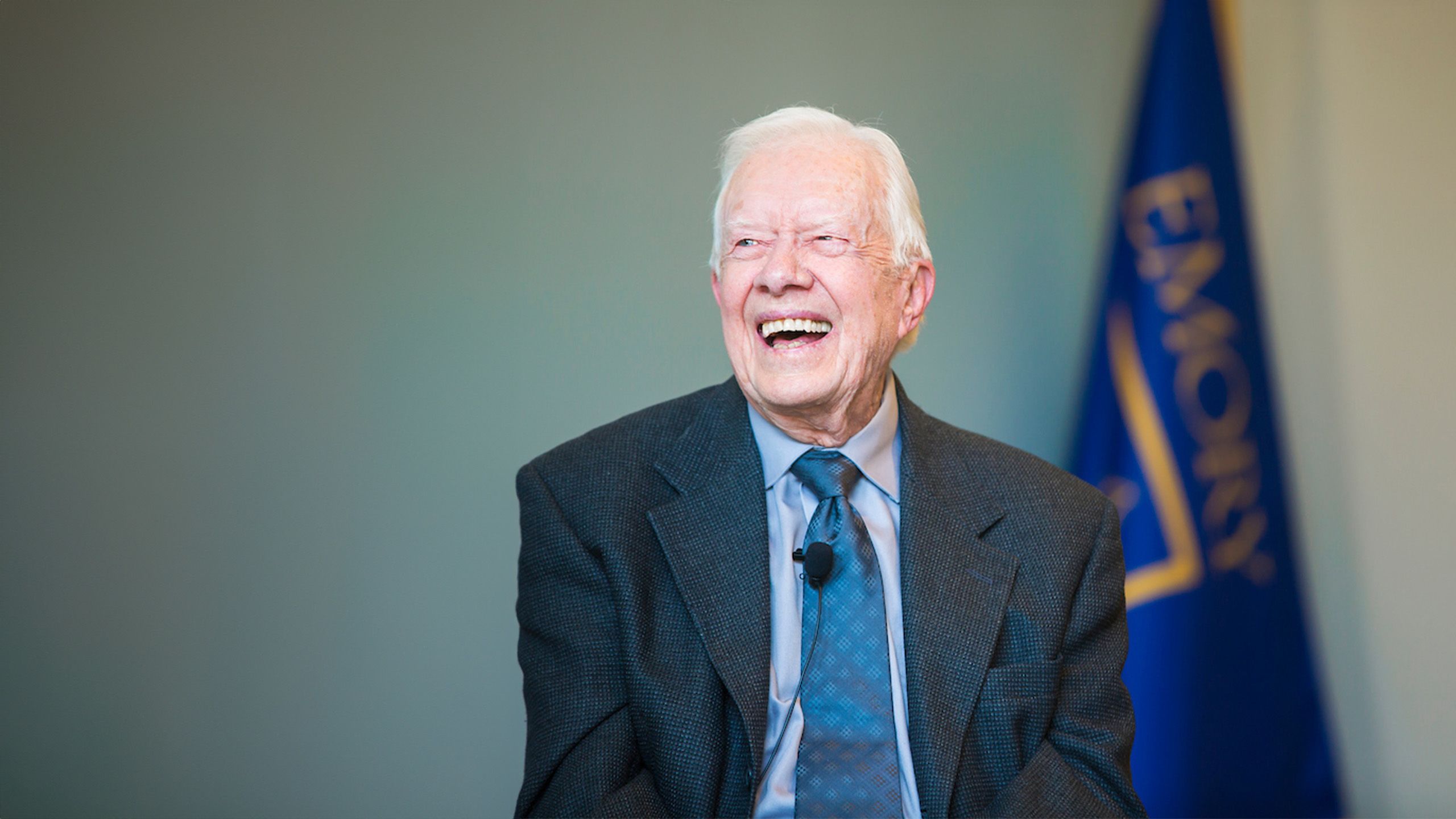
President Jimmy Carter, born just five years after Emory University moved from its original location in Oxford, Georgia, to Atlanta, has spent more than 40 years as an integral part of Emory.
From becoming a University Distinguished Professor after the conclusion of his presidential service to establishing The Carter Center from the tenth floor of Emory’s Robert W. Woodruff Library while its permanent home was constructed, President Carter has had an outsized impact on the university and, ultimately, the world.
During the 38 years that he delivered the Carter Town Hall at Emory, some 50,000 students heard unforgettable stories of his time on the world stage.
Numerous staff at The Carter Center are Emory graduates, and more than 2,000 Emory undergraduates and graduate assistants have served as interns there.
As a University Distinguished Professor, President Carter has lectured and visited in dozens of classes and holds tenure in four Emory schools: Emory College of Arts and Sciences, Oxford College, Candler School of Theology and Rollins School of Public Health.
“I would like to be remembered as a champion of human rights, as a president who kept our country at peace and as having been a distinguished professor at Emory University.”

President Carter’s early years
James Earl Carter Jr. — better known as Jimmy Carter — was born in Plains, a small town south of Atlanta. No one could have predicted the impact he would have on not only the state, but the country and the world.
Keep reading to learn about his early life and political career in Georgia.
1924: The year President Carter was born
- The first Winter Olympics are held in Chamonix, France.
- Iodized table salt first appears on grocery store shelves.
- The Ford Motor Company manufactures the 10 millionth Model T Ford.
- The first Macy’s Thanksgiving Day Parade is held in New York City.
- The average U.S. life expectancy for a man born in 1924: 58.1 years.
1919
Emory University, founded in 1836 in Oxford, Georgia, moves to its current location in Atlanta.
The Theology Building on Emory’s Atlanta campus, circa 1920. (Stuart A. Rose Manuscript, Archives and Rare Book Library)
The Theology Building on Emory’s Atlanta campus, circa 1920. (Stuart A. Rose Manuscript, Archives and Rare Book Library)
1924
Jimmy Carter is born in Plains, Georgia, the first U.S. president to be born in a hospital. His father, James Earl Carter Sr., was a farmer and businessman; his mother, Lillian Gordy Carter, a registered nurse.
James “Jimmy” Earl Carter Jr. with Lillian Carter (left) in 1924. Carter in 1928 pictured with Lady the Shetland pony (center). Carter pictured with his dog, Bozo (right). (Jimmy Carter Library)
James “Jimmy” Earl Carter Jr. with Lillian Carter (left) in 1924. Carter in 1928 pictured with Lady the Shetland pony (center). Carter pictured with his dog, Bozo (right). (Jimmy Carter Library)
1941
After completing 11th grade, Carter graduates from Plains High School, which did not have a 12th grade until 1952.
A classroom of President Jimmy Carter when he attended Plains High School in 1937 is exhibited in what is now the Jimmy Carter National Historic Site in his hometown of Plains. (David Goldman, AP Photo)
A classroom of President Jimmy Carter when he attended Plains High School in 1937 is exhibited in what is now the Jimmy Carter National Historic Site in his hometown of Plains. (David Goldman, AP Photo)
1946
Carter graduates from the U.S. Naval Academy and shortly thereafter weds Rosalynn Smith at Plains Methodist Church. In the Navy he becomes a submariner, serving in both the Atlantic and Pacific fleets, rising to the rank of lieutenant. He resigns in 1953, after his father’s death, to return to Plains and lead the Carter farms.
Rosalynn and Jimmy Carter celebrate their wedding day. (Atlanta Journal-Constitution, AP Photo)
Rosalynn and Jimmy Carter celebrate their wedding day. (Atlanta Journal-Constitution, AP Photo)
1963-67
Carter serves as a Georgia state senator from the 14th District. His successful senatorial campaign was brief, lasting just longer than one month.
Georgia State Sen. Jimmy Carter hugs his wife, Rosalynn, at his Atlanta campaign headquarters in 1966. (AP Photo)
Georgia State Sen. Jimmy Carter hugs his wife, Rosalynn, at his Atlanta campaign headquarters in 1966. (AP Photo)
1971-75
As the 76th governor of Georgia, Carter focuses on issues including strengthening education and introducing mental health programs.
Gov. Jimmy Carter takes the oath of office during ceremonies at the state capitol in Atlanta on Jan. 12, 1971. (AP Photo)
Gov. Jimmy Carter takes the oath of office during ceremonies at the state capitol in Atlanta on Jan. 12, 1971. (AP Photo)
“Emory’s decades-long partnership with The Carter Center is unlike any other in higher education, benefiting communities the world over. It continues to harness the immense talent of Emory scholars and alumni, applying their research and expertise to carry out President Carter’s profound vision for peace, health and human rights across continents and borders.”

Presidential partnership with Emory
During his time serving in the Oval Office, President Carter visited Emory multiple times, in what would grow to be a deep and long-lasting relationship. From Carter becoming a university professor to collaborating to build The Carter Center, Emory has benefited from his wisdom across numerous fronts.
Keep reading to learn more about President Carter’s work with Emory.
1982: The year President Carter became a professor at Emory
- “ET: The Extraterrestrial” and Michael Jackson’s “Thriller” album are released.
- The Commodore 64 home computer debuts.
- Diet Coke is introduced.
- The U.S. fails to ratify the Equal Rights Amendment.
- The average U.S. life expectancy for a man born in 1982: 70.8 years.
1976
Defeating incumbent Gerald Ford, Carter is elected president of the United States. During his campaign, he focused on the maintenance of peace, pursuit of human rights, necessity of international cooperation and more.
Jimmy Carter speaking at the Democratic National Convention in New York City, July 1976. (AP Photo)
Jimmy Carter speaking at the Democratic National Convention in New York City, July 1976. (AP Photo)
1977-81
Carter serves as the 39th president of the United States. Policy accomplishments of his administration include the Panama Canal treaties, the Camp David Accords, the treaty of peace between Egypt and Israel, the SALT II treaty with the Soviet Union, and the establishment of U.S. diplomatic relations with the People's Republic of China.
President Jimmy Carter takes the oath of office, as his wife, Rosalynn, holds the family Bible, during the inauguration ceremony in January 1977. (AP Photo)
President Jimmy Carter takes the oath of office, as his wife, Rosalynn, holds the family Bible, during the inauguration ceremony in January 1977. (AP Photo)
1977
James T. Laney becomes president of Emory University, a role he holds until 1993. Laney is instrumental in building the university’s close relationship with Carter.
President Jimmy Carter attends breakfast at the Houston Mill House with Emory President James Laney in 1983. (Emory Photo/Video)
President Jimmy Carter attends breakfast at the Houston Mill House with Emory President James Laney in 1983. (Emory Photo/Video)
1979
Emory receives a $105 million gift from Robert W. Woodruff, the late philanthropist and legendary leader of The Coca-Cola Company.
Robert W. Woodruff (center) with students of the Woodruff Health Sciences Center. (Photo via Emory Woodruff Scholars Program)
Robert W. Woodruff (center) with students of the Woodruff Health Sciences Center. (Photo via Emory Woodruff Scholars Program)
1979
At the invitation of Laney, Carter visits Emory during his presidency to help break ground for Cannon Chapel. During the visit, Carter receives an honorary doctor of laws degree from Emory.
President Jimmy Carter breaks ground for the William Cannon Chapel and Religious Center at Emory University on Aug. 30, 1979, alongside Emory President James T. Laney. (AP Photo)
President Jimmy Carter breaks ground for the William Cannon Chapel and Religious Center at Emory University on Aug. 30, 1979, alongside Emory President James T. Laney. (AP Photo)
1982
After the conclusion of his presidential service, Carter joins Emory’s faculty as a University Distinguished Professor. During the following decades, he visits campus frequently to visit with students, teach classes and deliver lectures.
President Jimmy Carter speaks at a forum with international students in 1996. (Kay Hinton, Emory Photo/Video)
President Jimmy Carter speaks at a forum with international students in 1996. (Kay Hinton, Emory Photo/Video)
1982
President Carter and Emory University establish The Carter Center, initially headquartered in an office on the tenth floor of Emory’s Robert W. Woodruff Library while its permanent home is constructed just a few miles away.
President Carter speaks at a conference with President Gerald Ford, who assisted The Carter Center in monitoring foreign elections. (Emory Photo/Video)
President Carter speaks at a conference with President Gerald Ford, who assisted The Carter Center in monitoring foreign elections. (Emory Photo/Video)
“I’ve taught in all the schools at Emory. It has kept me aware of the younger generation, their thoughts and ideals.”

A legacy of service
After leaving the White House, President Carter continued to devote his time to humanitarian efforts while starting an annual tradition of town halls for Emory’s first-year students. For 38 years, he gave students a unique window into his life and priorities. As a University Distinguished Professor, he also held regular luncheons with small groups of faculty and staff, and appeared in classes and special forums during the academic year.
Over the decades, coordinated efforts on the part of The Carter Center and Emory have resolved conflict, advanced democracy and human rights, improved African farm productivity, prevented disease and improved physical and mental health care.
Keep reading to learn more about President Carter’s collaboration with Emory.
2002: The year President Carter won the Nobel Peace Prize
- The musical “Hairspray” opens on Broadway.
- Kmart and Napster file for bankruptcy.
- Kelly Clarkson wins the premiere season of “American Idol.”
- The euro becomes the official currency in 12 of 15 European Union nations.
- The average U.S. life expectancy for a man born in 2002: 74.5 years.
1982
Carter begins a tradition of an annual town hall for Emory’s first-year students, deftly fielding a variety of student-submitted questions, ranging from the political to the personal.
President Carter speaking to Emory students at the first Carter Town Hall, held in 1982. (Emory Photo/Video)
President Carter speaking to Emory students at the first Carter Town Hall, held in 1982. (Emory Photo/Video)
1986
The Jimmy Carter Presidential Library and Museum and The Carter Center open in their permanent locations, set within a 35-acre wooded park in downtown Atlanta.
The dedication of The Carter Center on Oct. 1, 1986, President Carter's birthday. Sharing the platform with him were Mrs. Carter as well as President and Mrs. Reagan. President Reagan playfully advised Carter that "life begins at 70." (Carter Center Archives)
The dedication of The Carter Center on Oct. 1, 1986, President Carter's birthday. Sharing the platform with him were Mrs. Carter as well as President and Mrs. Reagan. President Reagan playfully advised Carter that "life begins at 70." (Carter Center Archives)
1999
Jimmy and Rosalynn Carter are awarded the Presidential Medal of Freedom, the nation’s highest civilian honor, by President Bill Clinton during a ceremony at The Carter Center in Atlanta.
President Clinton applauds Rosalynn and Jimmy Carter after awarding them the Presidential Medal of Freedom on Aug. 9, 1999. (Susan Walsh, AP Photo)
President Clinton applauds Rosalynn and Jimmy Carter after awarding them the Presidential Medal of Freedom on Aug. 9, 1999. (Susan Walsh, AP Photo)
1999
In one of his many campus activities through the years, President Carter joins Archbishop Desmond Tutu, a Woodruff Visiting Professor at Emory for the year, in a discussion about peace facilitated by then-Candler Dean Kevin LaGree in Cannon Chapel.
President Carter joins Dean Kevin LaGree (center) and Archbishop Desmond Tutu in Emory’s Cannon Chapel. (Ann Borden, Emory Photo/Video)
President Carter joins Dean Kevin LaGree (center) and Archbishop Desmond Tutu in Emory’s Cannon Chapel. (Ann Borden, Emory Photo/Video)
2001
Carter dedicates Emory’s Lillian Carter Center for Global Health and Social Responsibility (then called the Lillian Carter Center for International Nursing), named for his mother, a nurse and social advocate.
Lillian Carter shares a moment with a child during a global health trip (via the Lillian Carter Center for Global Health and Social Responsibility)
Lillian Carter shares a moment with a child during a global health trip (via the Lillian Carter Center for Global Health and Social Responsibility)
2002
Jimmy Carter receives the Nobel Peace Prize for work with The Carter Center, specifically “for his decades of untiring effort to find peaceful solutions to international conflicts, to advance democracy and human rights, and to promote economic and social development.”
President Carter accepts the Nobel Peace Prize during a ceremony in Oslo City Hall on Dec. 10, 2002. (Carter Center Archives)
President Carter accepts the Nobel Peace Prize during a ceremony in Oslo City Hall on Dec. 10, 2002. (Carter Center Archives)
2014
Carter celebrates his 90th birthday with a tour of a new butterfly garden created in his honor. The Jimmy and Rosalynn Carter Pollinator Garden at The Carter Center was designed with the help of Emory evolutionary ecologist Jaap de Roode and undergraduate students from his lab.
Emory professor Jaap de Roode (bottom right) and his children Jakob and Ella with Rosalynn and Jimmy Carter during a tour of the butterfly garden. (The Carter Center)
Emory professor Jaap de Roode (bottom right) and his children Jakob and Ella with Rosalynn and Jimmy Carter during a tour of the butterfly garden. (The Carter Center)
2015
A team of specialists at Winship Cancer Institute of Emory University begins treating Carter for metastatic melanoma. He undergoes surgery, radiation and immunotherapy.
Watch Carter discuss his cancer treatment at Winship Cancer Institute.
Former U.S. President Jimmy Carter reflected on his life’s work during a 2015 press conference in which he discussed his cancer diagnosis. (Jack Kearse, Woodruff Health Sciences Center Communications)
Former U.S. President Jimmy Carter reflected on his life’s work during a 2015 press conference in which he discussed his cancer diagnosis. (Jack Kearse, Woodruff Health Sciences Center Communications)
2015
President Carter receives the Emory University President’s Medal, among the university’s highest honors, during the annual Carter Town Hall.
Then-Emory President James W. Wagner presents Carter with the Emory President's Medal, which "recognizes those who have, through art and/or intellect, advanced human understanding and the cause of peace." (Ann Watson, Emory Photo/Video)
Then-Emory President James W. Wagner presents Carter with the Emory President's Medal, which "recognizes those who have, through art and/or intellect, advanced human understanding and the cause of peace." (Ann Watson, Emory Photo/Video)
2017
As the Emory School of Law marks 100 years, President Carter delivers the annual Bederman Lecture, discussing “Human Rights in Today’s World.”
Speaking April 6 in Emory's Glenn Memorial Auditorium, Jimmy Carter offers a somber assessment of human rights around the world, but says he’s "still hopeful because of the heroism I see." (Emory Photo/Video)
Speaking April 6 in Emory's Glenn Memorial Auditorium, Jimmy Carter offers a somber assessment of human rights around the world, but says he’s "still hopeful because of the heroism I see." (Emory Photo/Video)
2019
Emory grants Carter tenure in Emory College of Arts and Sciences, Oxford College, Candler School of Theology and Rollins School of Public Health.
President Jimmy Carter speaks to Oxford College students at The Carter Center in 2019. (Kay Hinton, Emory Photo/Video)
President Jimmy Carter speaks to Oxford College students at The Carter Center in 2019. (Kay Hinton, Emory Photo/Video)
2019
Carter delivers his final in-person town hall for first-year Emory students, concluding an unbroken 38 years of the campus tradition.
President Jimmy Carter fields questions from students at the 38th annual Emory town hall in 2019. (Emory Photo/Video)
President Jimmy Carter fields questions from students at the 38th annual Emory town hall in 2019. (Emory Photo/Video)
2020
With most in-person events canceled due to COVID-19, President Carter participates in his last Carter Town Hall through a recorded interview with his grandson, Jason Carter. After the pandemic, the town hall continued with other acclaimed speakers as Carter retires from public life.
The 2020 Carter Town Hall featured Jason Carter and a recorded interview with Jimmy Carter, shown here together at an event in Plains in 2017. (David Goldman, AP Photo)
The 2020 Carter Town Hall featured Jason Carter and a recorded interview with Jimmy Carter, shown here together at an event in Plains in 2017. (David Goldman, AP Photo)
2023
Reflecting the long collaboration between Emory and the Carters, Emory’s Glenn Memorial United Methodist Church hosts the national tribute service for Rosalynn Carter, who passed away Nov. 19 at their home in Plains. President Carter, age 99 and in hospice care, travels to Emory to attend the service for his beloved partner and wife of 77 years.
Hundreds of invited guests filled the church on Emory’s campus to honor the former first lady’s legacy. (Brynn Anderson, Associated Press Pool)
Hundreds of invited guests filled the church on Emory’s campus to honor the former first lady’s legacy. (Brynn Anderson, Associated Press Pool)
2024
The longest-living president in U.S. history, Jimmy Carter celebrates his 100th birthday on Oct. 1.
President Jimmy Carter addresses a Candler School of Theology class in 2010. (Bryan Meltz, Emory Photo/Video)
President Jimmy Carter addresses a Candler School of Theology class in 2010. (Bryan Meltz, Emory Photo/Video)
Video Gallery
View highlights from Carter Town Halls through the years.
Watch President Jimmy Carter discuss research at Winship Cancer Institute of Emory University.

Written by Michelle Ricker. Edited by Leigh DeLozier and Laura Douglas-Brown. Designed by Ruby Katz.
To learn more about Emory, please visit:
Emory News Center
Emory University


